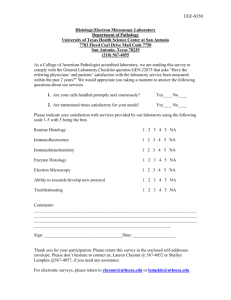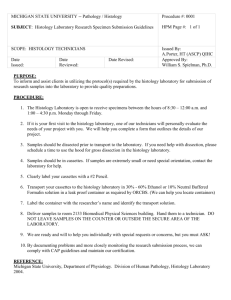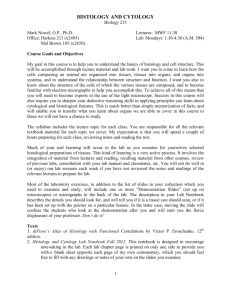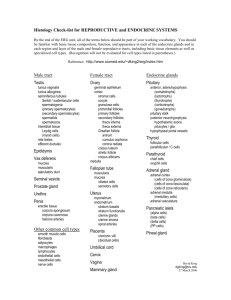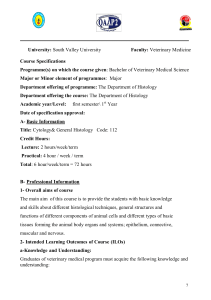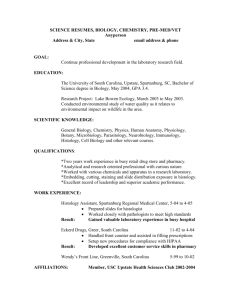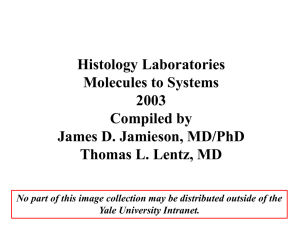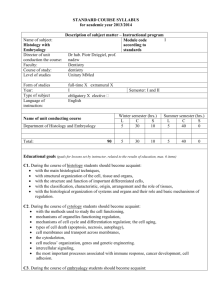Histology and cytophysiology
advertisement
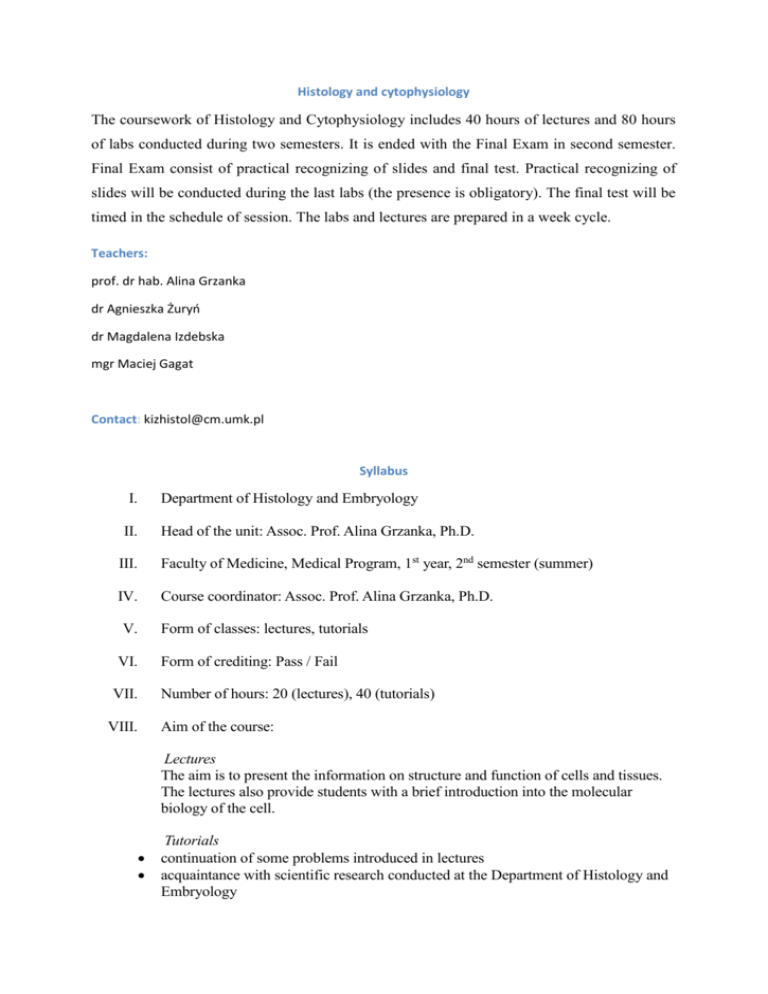
Histology and cytophysiology The coursework of Histology and Cytophysiology includes 40 hours of lectures and 80 hours of labs conducted during two semesters. It is ended with the Final Exam in second semester. Final Exam consist of practical recognizing of slides and final test. Practical recognizing of slides will be conducted during the last labs (the presence is obligatory). The final test will be timed in the schedule of session. The labs and lectures are prepared in a week cycle. Teachers: prof. dr hab. Alina Grzanka dr Agnieszka Żuryń dr Magdalena Izdebska mgr Maciej Gagat Contact: kizhistol@cm.umk.pl Syllabus I. Department of Histology and Embryology II. Head of the unit: Assoc. Prof. Alina Grzanka, Ph.D. III. Faculty of Medicine, Medical Program, 1st year, 2nd semester (summer) IV. Course coordinator: Assoc. Prof. Alina Grzanka, Ph.D. V. VI. VII. VIII. Form of classes: lectures, tutorials Form of crediting: Pass / Fail Number of hours: 20 (lectures), 40 (tutorials) Aim of the course: Lectures The aim is to present the information on structure and function of cells and tissues. The lectures also provide students with a brief introduction into the molecular biology of the cell. Tutorials continuation of some problems introduced in lectures acquaintance with scientific research conducted at the Department of Histology and Embryology IX. work with the cytological and histological preparations estimation of cellular structures at the electron microscopy level Topics of lectures / tutorials: Lectures: Introduction to cytology and histology. Cell membrane – structure and functions. Transport across cell membranes. Adhesion molecules (integrins, cadherins, selectins). Structure, basic functions and chemical compositions of endoplasmic reticulum, ribosomes, Golgi apparatus and mitochondria. 5. The cell nucleus. Its structure and function. 6. Non-membrane-bounded organelle: centrosome, cytoskeleton. 7. Cell cycle. 8. Cell differentiation and senescence. 9. Apoptosis pathways. Another types of cell death. 10. Epithelial tissue – characteristics, classification, functions and origin. Intercellular connection occurring in epithelial tissue. 11. Classification of connective tissues. Connective tissue proper. 12. Supporting connective tissue (cartilage and bone). 13. Blood and lymph. 14. Muscular tissue – characteristics and classification. 15. Nervous and glia tissue – structure, functions, origin. 1. 2. 3. 4. Tutorials: 1. Practical acquaintance with methods and techniques used in cytology, histology and cytophysiology. 2. Cell membrane. 3. Cellular receptors. 4. Proteosomes, peroxisomes, lysosomes. 5. Nucleolus. 6. Cytoskeleton. 7. Cell cycle. 8. Cell growth, differentiation and senescence. 9. Apoptosis. 10. Epithelial tissue. 11. Connective tissue proper. 12. Supporting connective tissue. 13. Blood and lymph. 14. Muscular tissue. 15. Nervous and glia tissue. X. Self-study topics: ----------- XI. Booklist: Basic: Junqueira LC, Carneiro J. Basic Histology: Text and Atlas. McGraw-Hill 2005; Eleventh Edition. Mescher AL. Junqueira's Basic Histology: Text and Atlas. McGraw-Hill, 2009; Twelve Edition. Additional: Ross MH, Kaye GI, Pawlina W. Histology. A text and atlas with cell and molecular biology. Williams &Wilkins 2003; Fourth Edition. Sobotta/Hammersen. Histology, A Colour Atlas of Cytology, Histology and Microscopic Anatomy. Urban & Schwarzenberg 1996. XII. Name: Detailed list of required practical skills and confirmation of completing: Year of study: Group: Academic year: Date Confirmation of completing Notes Recognizing of normal human organs on slides stained with different histological techniques. Recognizing of ultrastructural elements of different cell types on electronograms. Rules and regulations Obligatory textbook: Junqueira LC, Carneiro J. Basic Histology: Text and Atlas. McGraw-Hill 2005; Eleventh Edition. Mescher AL. Junqueira's Basic Histology: Text and Atlas. McGraw-Hill, 2009; Twelve Edition. Additional textbooks: Ross MH, Kaye GI, Pawlina W. Histology. A text and atlas with cell and molecular biology. Williams &Wilkins 2003; Fourth Edition. Sobotta/Hammersen. Histology, A Colour Atlas of Cytology, Histology and Microscopic Anatomy. Urban & Schwarzenberg 1996. Requirements 1. Students are obliged to prepare the part of material for each lab from the last topic. 2. The labs are obligatory. In the case of the illness a sick leave has to be delivered. Other absences due to important reason must be documented. 3. Two unjustified and undocumented absences make it impossible to pass the semester and take the Final test. 4. Each Student is obliged to come for the labs on time. Delayed Students can enter the class only if the time of delaying does not exceed 15 minutes from the moment a lab has been started. 5. In the case of absence or delay (more than 15 minutes) the Student is obliged to pass the material which was covered during the labs within 2 weeks. 6. In the case of fail the entrance test the Student is obligated retake the test within 2 weeks. 7. If Student does not pass the failed material during fixed time, he or she is obligated to retake the test within the last 2 weeks of each semester. 8. Students are obliged to bring pencils, color pencils and worksheets. 9. Students are obligated to complete worksheets during each lab. 10. Students are obligated to clean up after themselves. 11. Any accidents, injuries and other emergencies must be immediately reported to the practice leader. 12. Eating, drinking, and using mobile phones during the labs are prohibited. Point system 1. Each lab (except the first labs in the first semester and second semester) will be entered with 10-questioned test. For each correct answer Student will receive two points. Only students who will gain at least 6 points pass the test. 2. The labs in the first semester will be passed if all entrance tests and worksheets are passed. 3. Practical recognizing of slides will be concerned with recognizing of histological preparations and electronograms. 4. Students can take the Final Exam on condition that they pass labs and the practical. 5. Students are eligible to be exempt from Final Exam if all entrance tests and worksheets are passed the first time (only if they hold a mark above 70% form each entrance test). Final Exam 1. The Final Exam consists of multiple choice questions (only one answer correct). 2. Students who failed the Final Exam are obliged to retake the test. 3. The final scores of the Final Exam are not changeable. 4. The scores of the failed Final Exam and the retake will be confirmed by a signature in the Student Book as two separated scores but not as the mean of these two. 5. An excuse for absence should be submitted to the examiner the next day, or in justified circumstances, within three days after the Final Exam. 6. The Final Exam will be assessed according to given marks: (Fail) – less than 60% (3) – 60% (3,5) – 65 % (4) – 70% (4,5) – 80 % (5) – 90%
